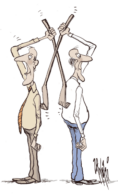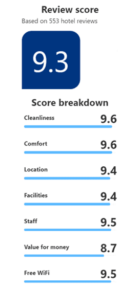How to persuade clients to buy


Do you know how to persuade your clients to buy? Certainly you do, otherwise your company would have closed down by now. And are you satisfied with the success rate?
If you could increase it, it would certainly boost your company's growth. Persuading clients to buy is both a science and an art. It requires understanding the client's motivations for buying and getting them to buy.
Persuading sometimes has a negative connotation, yet everyone does it:
- A newborn baby cries to persuade his mother to feed him.
- A child approaches other children to persuade them to play together.
- A boy approaches a girl to persuade her to go on a date.
- A young woman approaches a recruiter to persuade him to hire her.
- A man approaches his boss to persuade her to promote him.
In companies, people in marketing teams run communication campaigns to persuade clients to buy their products and services and people in sales teams contact clients with the same objective.
So there's no doubt that the ability to persuade is essential for a company's success. The question is whether marketing and sales teams persuade clients more by instinct and experience or more by method and experience.
Furthermore, persuasion must not include false or erroneous arguments, because immediate success can turn into failure in the long term, not only with regard to the misled client but also with regard to all the people the client tells about the bait they have fallen for (various studies report between 8 and 20 people on average).
Some persuasion techniques
Marketing and sales teams can use various techniques to persuade clients to buy.
Association

Association is a persuasion technique widely used in marketing and can also be used by sales teams. By associating the image of attractive people with a product, it becomes more attractive to clients. If the people are also famous (e.g. sportspeople, actors, musicians), they become brand ambassadors. In the picture above, actress Charlize Theron contributes to increasing the attractiveness of the Dior brand.
Affinity

Affinity is a persuasion technique increasingly used in marketing to specific client segments. The figure above illustrates the fans of a sports club, who have an emotional relationship with the club and often prefer the products sold under the club's brand to those of other brands, even if those products have little or no connection to sport (e.g. insurance). In sales, clients often choose to buy from salespeople who have the same preferences (e.g. sports, hobbies, books) or who have something in common (e.g. they went to the same school).
Authority

Authority is a persuasion technique that consists of invoking the name of someone (e.g. an expert) or some reference organization (e.g. a regulator, an organization that produces statistics or a court - as illustrated above) that refers positively to our brand or features of our product and service offering. This technique is very effective because people tend to trust the opinion of someone who they recognize as having specialist knowledge and is considered an authority on the subject. As they say, better than an expert defending your brand, only more than one expert. That's why marketing and sales teams use this technique whenever they can.
Contrast
Contrast is a persuasion technique that consists of presenting the client with alternatives (usually two or three) to facilitate their purchasing decision. It has an important advantage, which is that it covers different client segments at the same time. When used by marketing teams, the differences between the alternatives are usually more pronounced than when it is used by sales teams, who have more precise information about the client's context, i.e. their needs and preferences.

Cooperation

Cooperation is a persuasion technique used by sales teams. It consists of putting together a set of products and services for the client to purchase, in which the salesperson proposes special conditions (because it's a multiple purchase), but subject to superior approval, telling the client that he will persuade the boss to approve the transaction. He then goes to where the boss is and, with more or less drama, gets approval, returning with a smile to where the client is. This technique is used in face-to-face sales, but it can also be used in telephone sales.
Envy
Envy is a persuasion technique that appeals to the human feeling of not wanting to be left behind. It is used by marketing and sales departments to persuade clients to buy something they don't have or to buy something better than what they already have, using examples of other clients who have already purchased the brand's products and services.

Reciprocity

Reciprocity is a persuasion technique based on people's innate motivation to compensate others for something they have received. It is used in both marketing and sales. It can be as simple as offering sweets at the entrance to a store. For many years in November, I received a letter from an association of armless people who painted with brushes held by their toes, asking for a donation and giving me ten Christmas cards to send to people I knew. It was hard to refuse!
Scarcity
Scarcity is a persuasion technique with two variants. It can be used to illustrate the exceptionality of the offer (and the consequent reduced availability) or to illustrate the progressive reduction in the time available to purchase the offer, or a combination of both. The car in the picture above, which Bugatti called "voiture noire", was sold for 11 million euros plus tax, with the particularity of existing only one car. Recently, while I was on vacation, I saw a van with sound equipment driving around the streets advertising a circus show that evening, urging clients to buy tickets "before it sells out". Both marketing and sales departments use this technique whenever possible.

Social proof

Social proof is a persuasion technique used to reduce the client's perceived risk of a bad decision by illustrating that many other clients have already purchased the product or service on offer. It is used by marketing and sales departments and has become increasingly common since the advent of the internet. It can include a quantification given by clients to the quality of the offer (as illustrated in the figure above), or client testimonials, or both. A special case of social proof is using the opinion of a person of great influence, for example with many followers on social networks or with great media exposure.
The ability to persuade increases exponentially with the use of several techniques at the same time, for example in an auction, scarcity, envy and social proof are used.
There are other persuasion techniques, such as similarity, flattery, challenge, coherence, exclusivity, humility, vanity and altruism, which I'll cover on a future occasion.
Client's state of mind
Once you know about persuasion techniques, you need to have the discernment to use them at the right moment in the buying process.
In an article published in 1904, based on a proposal made in 1898 by Elias St. Elmo Lewis, Frank Hutchinson Dukesmith used the acronym AIDA to illustrate a consumer's state of mind during a buying process:

A company manages to get the consumer to reach each state of mind by publicizing its brand in one or more means of communication or through the action of a person who already knows the brand and/or the products or services on offer.
In the first case, the content of the communication can vary depending on the consumer's state of mind:
- The first state of mind to achieve is brand awareness. To get consumers to move from ignorance of the brand to knowledge of it, entertainment and video are effective to capture their attention, but there are countless ways to do this.
- The second state of mind to achieve is interest in the product or service on offer. To achieve this, companies need to explain the benefits and functionalities of their offer to consumers.
- The third state of mind to achieve is the desire to buy the product or service offering. To achieve this, companies need to explain to consumers the advantages of their offer over the competition.
- The last state of mind to achieve is the action of buying the product or service on offer. To achieve this, companies need to make the sale to consumers.
In the second case, the person can be active on behalf of the brand (typically from the sales department of the company that owns the brand or a business partner) or be unrelated to the brand (a consumer who has already used the product or service offering or someone who has heard of it). In the first situation, the focus of contact with the consumer is analogous to that described above for the first case. In the second situation, the contact is spontaneous on the part of the person, although the brand can stimulate this spontaneity.
The acronym AIDA also applies to organizations (B2B), in which case it is necessary to consider each person involved in the purchasing process because the main differences between B2B and B2C are the time taken for the sales process, the complexity derived from the number of buyers involved and the dimension of the offer, which is generally much larger in B2B.
Conclusion
Persuading clients to buy is essential to the success of any company. Marketing and sales teams need to master professionally what all people do from birth, which is to persuade other people to do what they want.
To do this, they need to use an appropriate methodology and learn from experience how to use the most effective persuasion techniques for each client segment and type of product and service offering.
Now that you know how to persuade clients to buy, you can create a skills development program for your marketing and sales teams to boost your company's growth.
Filipe Simões de Almeida
Managing Partner, Fi Consulting
Published on 28-Mar-2024
